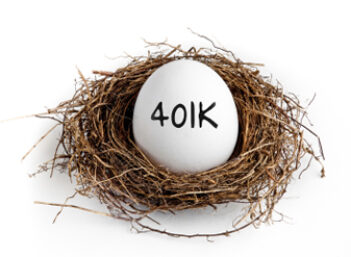Increasing numbers of people are setting up self-directed Individual Retirement Accounts (IRAs), allowing them to call their own investment shots. Unfortunately, most investors are short-changing their retirement by being timid.
There's no investment that beats the returns of stocks over the long-term and an IRA represents a vehicle for long-term money. So why shoot yourself in the foot by playing it too safe?
According to IRS statistics, about three-fourths of self-directed IRA money is in money market funds, government bonds or other fixed-income securities. That defies common sense.
A common 'risk-averse' mistake is to put IRA money into tax-exempt investments, such as annuities, municipal bonds and tax-exempt money market funds. These investments already are tax-exempt, so there’s no tax advantage to putting them in a tax-favored IRA. It's a double whammy: The tax-exempt status is bestowed in exchange for a lower yield, so you're doing yourself a disservice by wasting tax-exempt benefits on lower potential returns.
Another common mistake investors make is assuming that IRAs aren't worthwhile for high-income savers. On the contrary: Deductible or not, any money you deposit accumulates free of taxes as long as it stays there. This means your savings can grow and compound without having a big chunk sliced off for current taxes, as would be the case with an ordinary investment. The result is a pool of money that grows faster. And tax-deferred compounding gets sweeter the longer it lasts.
To really take advantage of an IRA, you've got to stay with stocks. If you're an older person nearing retirement and all you want to do is invest in cash or fixed-income investments, you're far better off just buying an annuity outside of the IRA. The bottom line is, money that won't go into stocks shouldn't go into your IRA.
Sound like heresy? The fact is, IRAs are for retirement investing, which means you need to take a long-term view, and that almost always means stocks. The lower rates of return that come with safer investment options will not begin to compensate you for the extra record-keeping hassles, costs and restrictions of IRAs, and will tarnish the luster of tax-deferred compounding.
When it comes to stocks, your best bets are companies with great growth potential, particularly those in a dominant position in their markets. In this regard, it's hard to go wrong with some of the stock recommendations that I've made on InvestingAnswers' sister site, StreetAuthority.com [click here].
Stocks have historically outpaced other types of investments because they provide opportunity for growth. Don't let today's volatile stock market and still-iffy economy frighten you out of stocks altogether. The advantage of stocks will only increase during the decade ahead because the stage is still set for moderate to low inflation.
Self-directed IRA accounts are typically set up through a broker, but you decide what and when to buy and sell. Call your broker and he or she will show you how to do it. However, since you're completely in charge of the account once it's set up, it's important to follow these basic guidelines:
Keep track of your returns: Because IRAs are invested for the long haul, investors tend to neglect regular monitoring of their returns. Don’t fall into this trap of complacency.
Limit trading: Although you should stay on top of market conditions, trading too aggressively doesn't make sense. You can't take a tax deduction for investment losses, nor can you deduct investment advisory fees and expenses. And remember: Brokers' commissions are added to the cost of the investment, which reduces capital gains.
Limit the number of accounts: Don't take out several IRAs at different banks, regardless of any enticing yields offered. This scattershot approach can eat away at your returns by exposing you to more transaction and account fees than necessary. By putting your IRAs under one umbrella, you can cut costs, trim red tape, and make it easier to stay on top of performance. Consolidating your IRA accounts, before distributions become mandatory at age 70 ½, can also help you keep track of your distributions and avoid penalties.
Learn contribution rules and limits: Many IRA investors have mistaken notions about how much they can save every year. Here are the latest IRS rules:
- If you are under 50 years of age at the end of the year, the maximum contribution you can make to a traditional or Roth IRA is the lesser of $5,000 or the amount of your taxable compensation for 2010. This limit can be split between a traditional and a Roth IRA but the combined limit is $5,000. The maximum contribution to a Roth IRA and the maximum deductible contribution to a traditional IRA may be reduced depending upon your modified adjusted gross income (modified AGI).
- If you are 50 years of age or older before 2011, the maximum contribution that can be made to a traditional or Roth IRA is the smaller of $6,000 or the amount of your taxable compensation for 2010. This limit can be split between a traditional and a Roth IRA but the combined limit is $6,000. The maximum contribution to a Roth IRA and the maximum deductible contribution to a traditional IRA may be reduced depending upon your modified AGI.
Don't forget that you'll have to pay taxes on any IRA withdrawals made before age 59 ½. And the IRS will impose a 10 percent early withdrawal penalty on the taxable portion of your early IRA withdrawal. For tax-deferred IRAs, this is the entire amount. For Roth IRAs, the 10 percent penalty applies only to the early withdrawal of earnings. This is a one-time penalty paid in the year of the early distribution.
Here’s the encouraging news: When people leave the workforce and start making allowable withdrawals, their income usually drops sharply—on average about 50 percent. That puts you in a lower tax bracket.
Finally, remember that in contrast to a traditional IRA, contributions to a Roth IRA are not tax-deferrable. Withdrawals are generally tax-free, but not always and not without certain stipulations. An advantage of the Roth IRA over a traditional IRA is that there are fewer withdrawal restrictions and requirements. Transactions inside the Roth IRA account do not incur a current tax liability. Your broker can fill in the details.
The bottom line? When it comes to a self-directed IRA, play it smart -- not safe.



